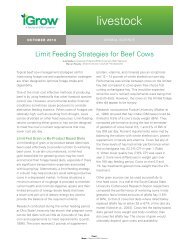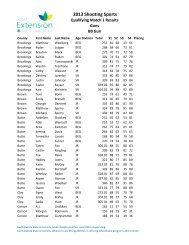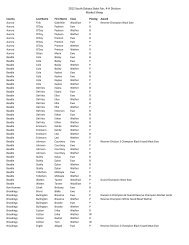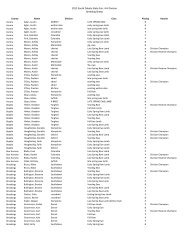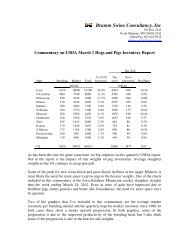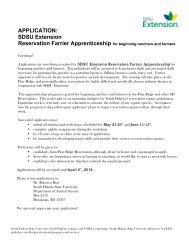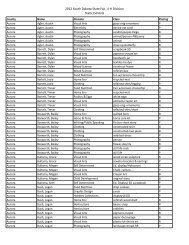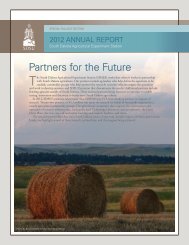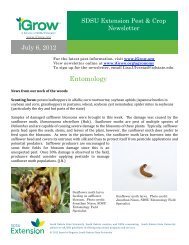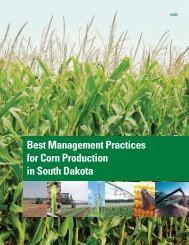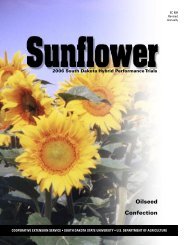South Dakota Flax Variety Evaluations 2009 - South Dakota State ...
South Dakota Flax Variety Evaluations 2009 - South Dakota State ...
South Dakota Flax Variety Evaluations 2009 - South Dakota State ...
You also want an ePaper? Increase the reach of your titles
YUMPU automatically turns print PDFs into web optimized ePapers that Google loves.
<strong>South</strong> <strong>Dakota</strong> <strong>State</strong> University / College of Agriculture & Biological Sciences / USDA<br />
1<br />
ExEx8055<br />
Oct. <strong>2009</strong><br />
Plant Science<br />
<strong>South</strong> <strong>Dakota</strong> <strong>Flax</strong> <strong>Variety</strong> <strong>Evaluations</strong><br />
<strong>2009</strong><br />
The success of flax production is affected by<br />
choice of variety. <strong>Variety</strong> characteristics such as<br />
seed yield, oil content, disease resistance, and<br />
maturity should be examined carefully when deciding<br />
which variety or varieties to plant. In some<br />
cases oil content or other traits may offset a yield<br />
advantage.<br />
YIELD<br />
Evaluate as much yield data as possible<br />
when selecting a variety, looking at relative<br />
performance over many locations and years. For<br />
example, variety comparisons over 3 years are<br />
better than those from a single year or location.<br />
A consistent performance of a variety over many<br />
environments is called yield stability.<br />
Good yield stability means that a variety may<br />
or may not be the best yielder at all locations, but<br />
it ranks high in yield potential at many locations.<br />
A variety that ranks in the upper 20% over all<br />
locations exhibits better yield stability than one<br />
that is the top yielder at two locations but ranks in<br />
the lower 40% at two other locations.<br />
To determine if one variety is better than<br />
another for a given trait, use the least significant<br />
difference (LSD.05) value at the bottom of each<br />
data column. The LSD value is a statistical way<br />
to indicate if a trait like yield differs when comparing<br />
two varieties. If two varieties differ by<br />
more than the indicated LSD value for a given<br />
trait, they will likely differ when grown again<br />
under highly similar conditions.<br />
Kathleen Grady, oilseed breeder and Extension specialist<br />
Lee Gilbertson, senior ag research technician<br />
SDSU Plant Science Department<br />
4 pages<br />
If the LSD.05 value is indicated as “ns,” it<br />
means that there were no statistically significant<br />
differences in yield among the varieties. In other<br />
words, the variety yields were all close enough to<br />
each other to be essentially the same, considering<br />
the amount of variation inherent in the test.<br />
When evaluating yield, look at as many trials<br />
as possible. Trial results from neighboring states<br />
are readily available and provide additional data<br />
on variety performance. It is unlikely that the<br />
environmental conditions of a test will repeat in<br />
any future year.<br />
The coefficient of variability (C.V.) listed at<br />
the bottom of the data table is a relative measure<br />
of the precision or reliability of a test. Generally,<br />
trials with low C.V. rates are more reliable for<br />
making variety choices than trials with higher<br />
C.V. rates. Trials with C.V. rates of 15-20% or<br />
less may be considered reliable.<br />
OIL CONTENT<br />
Among varieties with similar yield potential,<br />
select the one with the highest oil content. It does<br />
not pay to sacrifice yield for oil content, however.<br />
MATURITY<br />
Later-maturing varieties generally will produce<br />
higher yields than early varieties when<br />
seeded at normal planting dates. Maturity is particularly<br />
important if planting is delayed. In many<br />
cases of late seeding, only an early variety will<br />
mature properly and exhibit its best yield potential<br />
and oil content.
DISEASE RESISTANCE<br />
The two most serious flax diseases are wilt<br />
and rust. Currently, all commercially grown<br />
flax varieties are resistant to race 371 of the flax<br />
rust pathogen Melampsora lini. This is the most<br />
common naturally occurring rust race in North<br />
America. <strong>Flax</strong> wilt is caused by Fusarium oxysporum<br />
f. sp. lini, a soil-borne pathogen that can<br />
infect plants at any stage of development. It may<br />
cause wilting and death of seedlings or older<br />
plants, stunting, loss of vigor, and reduced yield.<br />
<strong>Flax</strong> varieties differ in their resistance to flax wilt.<br />
If flax is grown in a field with a history of wilt, a<br />
wilt-resistant variety should be selected. A fungicide<br />
seed treatment will provide early protection<br />
to infection by seed-borne and soil-borne organisms<br />
that cause seedling blight and damping-off.<br />
SEED AVAILABILITY AND QUALITY<br />
Seed sources for Canadian and some older<br />
flax varieties may be limited. Be sure to plant<br />
only high-quality seed with good germination.<br />
Certified seed is recommended to assure varietal<br />
purity, seed viability, and freedom from pathogens<br />
and weed seed.<br />
<strong>2009</strong> TRIAL PROCEDURES<br />
A yield trial of flax varieties and experimental<br />
lines from <strong>South</strong> <strong>Dakota</strong>, North <strong>Dakota</strong>, and<br />
Canada was grown at Brookings, S.D., in <strong>2009</strong>.<br />
The purpose of the trial was to provide performance<br />
data on released flax varieties to producers<br />
and compare performance of experimental lines<br />
to established checks in order to identify possible<br />
new varieties.<br />
In <strong>2009</strong>, five experimental lines from the<br />
NDSU or Canadian flax breeding programs were<br />
tested against 17 released varieties. The trial was<br />
planted on May 19, <strong>2009</strong>. The previous crop<br />
was oats. Experiment design was a randomized<br />
2<br />
complete block with three replications. Plots consisted<br />
of seven rows 20 ft. long, with rows spaced<br />
7 inches apart. Plots were harvested by cutting<br />
the middle three rows of each plot with a bundle<br />
cutter, then drying and threshing the bundles. Oil<br />
content was determined with a Bruker minispec<br />
NMR on oven-dried 35 ml seed samples from<br />
each plot. Oil contents were adjusted to 10%<br />
moisture basis.<br />
Table 1 shows <strong>2009</strong>, 2-, and 3-year average<br />
yield, oil, flowering, and height data for flax<br />
grown at Brookings, S.D. Table 2 summarizes<br />
the characteristics of the varieties included in the<br />
performance trials. Yields at Brookings in <strong>2009</strong><br />
averaged 26.7 bu/acre with 39.7% oil.<br />
ACKNOWLEDGEMENTS<br />
This research was supported in part by the<br />
<strong>South</strong> <strong>Dakota</strong> Oilseeds Council.<br />
<strong>South</strong> <strong>Dakota</strong> <strong>State</strong> University, <strong>South</strong> <strong>Dakota</strong> counties, and U.S. Department of Agriculture cooperating. <strong>South</strong> <strong>Dakota</strong> <strong>State</strong> University<br />
is an Affirmative Action/Equal Opportunity Employer and offers all benefits, services, education, and employment opportunities without<br />
regard for race, color, creed, religion, national origin, ancestry, citizenship, age, gender, sexual orientation, disability, or Vietnam Era<br />
veteran status.<br />
EXEX8055 Access at http://agbiopubs.sdstate.edu/articles/ExEx8055.pdf.
Table 1. <strong>2009</strong> <strong>Flax</strong> <strong>Variety</strong> Trial, Brookings, S.D.<br />
<strong>Variety</strong><br />
Origin<br />
-Year-<br />
Seed Yield Oil Flower Plant Height<br />
<strong>2009</strong> 2-yr 3-yr <strong>2009</strong> 2-yr 3-yr <strong>2009</strong> 2-yr <strong>2009</strong> 2-yr 3-yr<br />
(bu/ac) (%) (days) (inches)<br />
AC Hanley CAN-02 26.1 21.1 19.2 38.5 38.2 38.8 52 52 23.2 21.4 19.7<br />
Bison ND-27 28.2 19.8 19.9 38.7 38.3 39.0 47 49 23.6 22.4 20.6<br />
Carter ND-05 26.4 19.9 19.1 39.9 39.2 39.8 52 54 24.4 23.4 21.1<br />
CDC Arras CAN-00 19.4 18.3 17.1 39.4 38.9 39.4 51 53 24.8 23.4 21.2<br />
CDC Bethune CAN-00 19.5 16.9 16.5 39.2 38.7 39.4 51 53 25.2 24.1 21.7<br />
CDC Sorrel CAN-07 25.8 20.2 – 38.8 38.8 – 53 55 27.2 24.8 --<br />
Linott CAN-66 23.2 19.1 18.7 38.5 38.6 39.4 50 53 24.0 23.3 21.1<br />
McGregor CAN-82 25.4 21.2 20.2 38.2 38.0 38.6 53 54 24.0 23.0 21.1<br />
Nekoma ND-02 28.9 21.8 20.4 39.2 39.3 40.3 51 52 24.4 23.0 20.5<br />
Omega ND-90 23.3 19.2 18.8 40.7 39.9 40.5 49 51 20.9 20.4 19.1<br />
Pembina ND-97 28.0 22.5 19.6 39.0 39.0 39.7 53 53 25.2 23.4 21.3<br />
Prairie Blue CAN-03 31.8 23.8 21.4 40.1 39.9 40.5 53 53 26.4 23.4 21.1<br />
Prairie Grande CAN-08 24.8 20.3 -- 41.0 39.9 – 46 48 19.3 18.9 --<br />
Prairie Thunder CAN-08 32.6 25.1 22.2 39.9 39.5 40.0 50 50 21.3 20.5 19.0<br />
Rahab 94 SD-94 30.8 23.1 20.0 39.6 39.3 40.2 52 53 24.4 22.1 19.8<br />
Selby SD-00 32.7 23.5 21.6 39.0 38.8 39.8 52 54 24.4 23.1 21.3<br />
Webster SD-98 28.5 23.2 20.6 39.3 39.4 40.2 53 54 27.6 25.7 23.2<br />
Experimentals<br />
A603 ND-exp. 23.9 18.4 -- 39.3 38.7 – 51 54 23.6 21.7 –<br />
FP2188 CAN-exp. 24.1 22.5 -- 43.3 43.0 – 48 50 22.8 22.8 –<br />
FP2214 CAN-exp. 24.4 21.4 -- 42.1 41.8 – 49 51 24.0 22.0 –<br />
N06 2055 ND-exp. 30.9 26.4 -- 39.4 39.7 – 53 54 25.2 24.4 –<br />
N06 2059 ND-exp. 27.9 20.2 -- 40.2 40.0 – 52 54 27.6 25.0 –<br />
Mean 26.7 21.3 19.7 39.7 39.4 39.7 51.0 52 24.2 22.8 20.8<br />
LSD .05 ns 1 4.2 3.0 0.6 0.6 0.5 1.1 1 2.1 1.6 1.1<br />
C.V. 16.5 17.2 16.2 0.9 1.3 1.3 1.3 1.6 5.3 6.2 5.7<br />
1 ns indicates that differences among the varieties were not statistically significant.<br />
Seeding dates: <strong>2009</strong> – May 19th; 2008 – May 8th; 2007 – no trial; 2006 – April 26th<br />
<strong>South</strong> <strong>Dakota</strong> <strong>State</strong> University, <strong>South</strong> <strong>Dakota</strong> counties, and U.S. Department of Agriculture cooperating. <strong>South</strong> <strong>Dakota</strong> <strong>State</strong> University<br />
is an Affirmative Action/Equal Opportunity Employer and offers all benefits, services, education, and employment opportunities without<br />
regard for race, color, creed, religion, national origin, ancestry, citizenship, age, gender, sexual orientation, disability, or Vietnam Era<br />
veteran status.<br />
EXEX8055 Access at http://agbiopubs.sdstate.edu/articles/ExEx8055.pdf.<br />
3
Table 2. <strong>Flax</strong> <strong>Variety</strong> Characteristics<br />
<strong>Variety</strong><br />
Origin<br />
-Year-<br />
2-yr<br />
Days to<br />
Flower<br />
4<br />
Seed<br />
Size<br />
Color<br />
Disease 1<br />
Resistance<br />
Flower Seed Wilt Rust<br />
AC Hanley CAN-02 52 Med-Sm Blue Brown MR R<br />
Bison ND-27 49 Med-Lrg Blue Brown MR S<br />
Carter ND-05 54 Med-Sm Blue Yellow MS R<br />
CDC Arras CAN-00 53 Med-Lrg Blue Brown R R<br />
CDC Bethune CAN-00 53 Medium Blue Brown MR R<br />
CDC Sorrel CAN-07 55 Med-Lrg Blue Brown MR R<br />
Linott CAN-66 53 Medium Blue Brown MS R<br />
McGregor CAN-82 54 Small Blue Brown MR R<br />
Nekoma ND-02 52 Med-Sm Blue Brown S R<br />
Omega ND-90 51 Medium Blue Yellow MS R<br />
Pembina ND-97 53 Large Blue Brown R R<br />
Prairie Blue CAN-03 53 Small Blue Brown MR R<br />
Prairie Grande CAN-08 48 Medium Blue Brown MR R<br />
Prairie Thunder CAN-08 50 Medium Blue Brown R R<br />
Rahab 94 SD-94 53 Medium Blue Brown MR R<br />
Selby SD-00 54 Medium Blue Brown MR R<br />
Webster SD-98 54 Med-Lrg Blue Brown MR R<br />
Experimentals<br />
A603 ND-exp. 54 Med-Sm Blue Brown -- --<br />
FP2188 CAN-exp. 50 Medium Blue Brown -- R<br />
FP2214 CAN-exp. 51 Medium Blue Brown MR R<br />
N06 2055 ND-exp. 54 Large Blue Yellow -- --<br />
N06 2059 ND-exp. 54 Large Blue Yellow -- --<br />
1 R = resistant; MR = moderately resistant; MS = moderately susceptible; S = susceptible.<br />
<strong>South</strong> <strong>Dakota</strong> <strong>State</strong> University, <strong>South</strong> <strong>Dakota</strong> counties, and U.S. Department of Agriculture cooperating. <strong>South</strong> <strong>Dakota</strong> <strong>State</strong> University<br />
is an Affirmative Action/Equal Opportunity Employer and offers all benefits, services, education, and employment opportunities without<br />
regard for race, color, creed, religion, national origin, ancestry, citizenship, age, gender, sexual orientation, disability, or Vietnam Era<br />
veteran status.<br />
EXEX8055 Access at http://agbiopubs.sdstate.edu/articles/ExEx8055.pdf.



